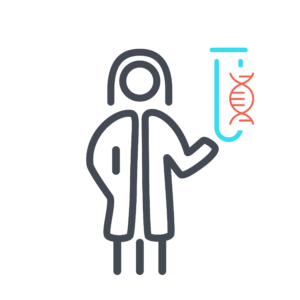CTBP1-Related Syndrome

Table of contents
- What is CTBP1-related syndrome?
- Key Role
- Symptoms
- What causes CTBP1-related syndrome?
- Why does my child have a change in the CTBP1 gene?
- What are the chances that other family members of future children will have CTBP1-related syndrome?
- How many people have CTBP1-related syndrome?
- Do people who have CTBP1-related syndrome look different?
- How is CTBP1-related syndrome treated?
- Behavior and development concerns linked to CTBP1-related syndrome
- Medical and physical concerns linked to CTBP1-related syndrome
- Where can I find support and resources?
CTBP1-related syndrome is also called hypotonia, ataxia, developmental delay, and tooth enamel defect syndrome (HADDTS). For this webpage, we will be using the name CTBP1-related syndrome to encompass the wide range of variants observed in the people identified.
What is CTBP1-related syndrome?
CTBP1-related syndrome happens when there are changes in the CTBP1 gene. These changes can keep the gene from working as it should.

Key Role
The CTBP1 gene plays an important role in controlling the cell cycle, the cell’s response to DNA damage, and cell metabolism, which is the process by which cells make energy.
Symptoms
Because the CTBP1 gene is important for brain activity, many people who have CTBP1-related syndrome have:
- Developmental delays
- Intellectual disability
- Feeding issues
- Low muscle tone
- Delayed motor abilities
- Walking issues
- Speech problems
- Brain changes seen on magnetic resonance imaging (MRI)
What causes CTBP1-related syndrome?
CTBP1-related syndrome is a genetic condition, which means that it is caused by variants in genes. Our genes contain the instructions, or code, that tell our cells how to grow, develop, and work. Every child gets two copies of the CTBP1 gene: one copy from their mother’s egg, and one copy from their father’s sperm. In most cases, parents pass on exact copies of the gene to their child. But the process of creating the egg or sperm is not perfect. A change in the genetic code can lead to physical issues, developmental issues, or both.
Sometimes a spontaneous variant happens in the sperm, egg or after fertilization. When a brand new genetic variant happens in the genetic code is called a ‘de novo’ genetic variant. The child is usually the first in the family to have the genetic variant.
De novo variants can take place in any gene. We all have some de novo variants, most of which don’t affect our health. But because CTBP1 plays a key role in development, de novo variants in this gene can have a meaningful effect.
Research shows that CTBP1-related syndrome is often the result of a de novo variant in CTBP1. Many parents who have had their genes tested do not have the CTBP1 genetic variant found in their child who has the syndrome. In some cases, CTBP1-related syndrome happens because the genetic variant was passed down from a parent.
Autosomal dominant conditions
CTBP1-related syndrome is an autosomal dominant genetic condition. This means that when a person has the one damaging variant in CTBP1 they will likely have symptoms of CTBP1-related syndrome. For someone with an autosomal dominant genetic syndrome, every time they have a child there is a 50 percent chance they pass on the same genetic variant and a 50 percent chance they do not pass on the same genetic variant.
Autosomal Dominant Genetic Syndrome
Why does my child have a change in the CTBP1 gene?
No parent causes their child’s CTBP1-related syndrome. We know this because no parent has any control over the gene changes that they do or do not pass on to their children. Please keep in mind that nothing a parent does before or during the pregnancy causes this to happen. The gene change takes place on its own and cannot be foreseen or stopped.
What are the chances that other family members of future children will have CTBP1-related syndrome?
Each family is different. A geneticist or genetic counselor can give you advice on the chance that this will happen again in your family.
The risk of having another child who has CTBP1-related syndrome depends on the genes of both biological parents.
- If neither biological parent has the same genetic variant found in their child, the chance of having another child who has the syndrome is on average 1 percent. This 1 percent chance is higher than the chance of the general population. The increase in risk is due to the very unlikely chance that more of the mother’s egg cells or the father’s sperm cells carry the same genetic variant.
- If one biological parent has the same genetic variant found in their child, the chance of having another child who has the syndrome is 50 percent.
For a symptom-free brother or sister of someone who has CTBP1-related syndrome, the sibling’s risk of having a child who has CTBP1-related syndrome depends on the sibling’s genes and their parents’ genes.
- If neither parent has the same genetic variant causing CTBP1-related syndrome, the symptom-free sibling has a nearly 0 percent chance of having a child who would inherit CTBP1-related syndrome.
- If one biological parent has the same genetic variant causing CTBP1-related syndrome, the symptom-free sibling has a 50 percent chance of also having the same genetic variant. If the symptom-free sibling has the same genetic variant, their chance of having a child who has the genetic variant is 50 percent.
For a person who has CTBP1-related syndrome, the risk of having a child who has the syndrome is about 50 percent.

How many people have CTBP1-related syndrome?
As of 2024, at least 16 people with CTBP1-related syndrome have been described in medical research.

Do people who have CTBP1-related syndrome look different?
People who have CTBP1-related syndrome may look different. Appearance can vary and can include some but not all of these features:
- Forehead that sticks out
- Underdeveloped chin
- Deep-set eyes
- Teeth issues

How is CTBP1-related syndrome treated?
Scientists and doctors have only just begun to study CTBP1-related syndrome. At this point, there are no medicines designed to treat the syndrome. A genetic diagnosis can help people decide on the best way to track the condition and manage therapies. Doctors can refer people to specialists for:
- Physical exams and brain studies
- Genetics consults
- Development and behavior studies
- Other issues, as needed
A developmental pediatrician, neurologist, or psychologist can follow progress over time and can help:
- Suggest the right therapies. This can include physical, occupational, speech, or behavioral therapy.
- Guide individualized education plans (IEPs).
Specialists advise that therapies for CTBP1-related syndrome should begin as early as possible, ideally before a child begins school.
If seizures happen, consult a neurologist. There are many types of seizures, and not all types are easy to spot. To learn more, you can refer to resources such as the Epilepsy Foundation’s website: epilepsy.com/learn/types-seizures.

This section includes a summary of information from major published articles. It highlights how many people have different symptoms. To learn more about the articles, see the Sources and References section of this guide.
Behavior and development concerns linked to CTBP1-related syndrome
Speech and learning
People with CTBP1-related syndrome had developmental delays or intellectual disabilities, and some people had motor or language regression. Many people had a speech condition that makes it difficult to form and pronounce words (dysarthria), and everyone had language delays.
- 14 out of 16 people had developmental delays or intellectual disabilities (88 percent)
- 4 out of 14 people had motor or language regression (29 percent)
- 9 out of 15 people had dysarthria (60 percent)

Behavior
Some people with CTBP1-related syndrome had behavioral challenges such as autism.
Brain
Some people with CTBP1-related syndrome had neurological issues, including brain changes seen on magnetic resonance imaging (MRI), such as cerebellar atrophy, seizures, and lower than average muscle tone (hypotonia).
- 10 out of 16 people had brain changes seen on MRI (63 percent)
- 1 out of 15 people had seizures (7 percent)
- 15 out of 16 people had hypotonia (94 percent)

Medical and physical concerns linked to CTBP1-related syndrome
Mobility
People with CTBP1-related syndrome had movement and walking issues, including poor muscle control that results in clumsy movements (ataxia), wide-based walking, walking with support, or were unable to walk. More than one-half had muscle weakness. Most people had growth delays.
- 11 out of 16 people had ataxia (69 percent)
- 4 out of 15 people had wide-based walking (27 percent)
- 2 out of 14 people walked with support (14 percent)
- 5 out of 15 people were unable to walk (33 percent)
- 9 out of 15 people had muscle weakness (60 percent)
Dental issues
Many people with CTBP1-related syndrome had tooth enamel defects, and about one-half of people had feeding difficulties.
- 12 out of 16 people had tooth enamel defects (75 percent)
Vision
Some people with CTBP1-related syndrome had difficulty moving their eyes from side to side (oculomotor apraxia).
- 11 out of 14 people had oculomotor apraxia (79 percent)

Where can I find support and resources?
Simons Searchlight
Simons Searchlight is an online international research program, building an ever growing natural history database, biorepository, and resource network of over 175 rare genetic neurodevelopmental disorders. By joining their community and sharing your experiences, you contribute to a growing database used by scientists worldwide to advance the understanding of your genetic condition. Through online surveys and optional blood sample collection, they gather valuable information to improve lives and drive scientific progress. Families like yours are the key to making meaningful progress. To register for Simons Searchlight, go to the Simons Searchlight website at www.simonssearchlight.org and click “Join Us.”
- Learn more about Simons Searchlight: www.simonssearchlight.org/frequently-asked-questions
- Simons Searchlight webpage with more information on CTBP1: www.simonssearchlight.org/research/what-we-study/ctbp1
- Simons Searchlight Facebook group: https://www.facebook.com/groups/ctbp1

The content in this guide comes from published studies about CTBP1-related syndrome.
- Acosta-Baena, N., Tejada-Moreno, J. A., Arcos-Burgos, M., & Villegas-Lanau, C. A. (2022). CTBP1 and CTBP2 mutations underpinning neurological disorders: A systematic review. Neurogenetics, 23(4), 231-240. https://pmc.ncbi.nlm.nih.gov/articles/PMC9663338/
- Kadhim, H., El-Howayek, E., Coppens, S., Duff, J., Topf, A., Kaleeta, J. P., Simoni, P., Boitsios, G., Remiche, G., … & Deconinck, N. (2023). A pathogenic CTBP1 variant featuring HADDTS with dystrophic myopathology. Neuromuscular Disorders, 33(5), 410-416. https://pubmed.ncbi.nlm.nih.gov/37037050/
- Zhang, Q., Liu, Y., Liu, X., Zhao, Y., & Zhang, J. (2024). A novel CTBP1 variant in a Chinese pediatric patient with a phenotype distinct from hypotonia, ataxia, developmental delay, and tooth enamel defect syndrome. Frontiers in Genetics, 15, 1344682. https://pmc.ncbi.nlm.nih.gov/articles/PMC10859494/
